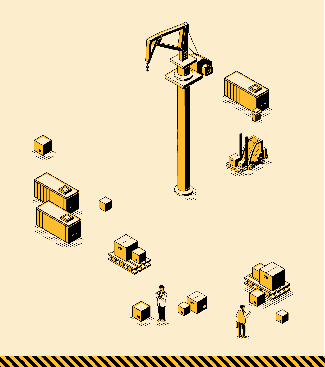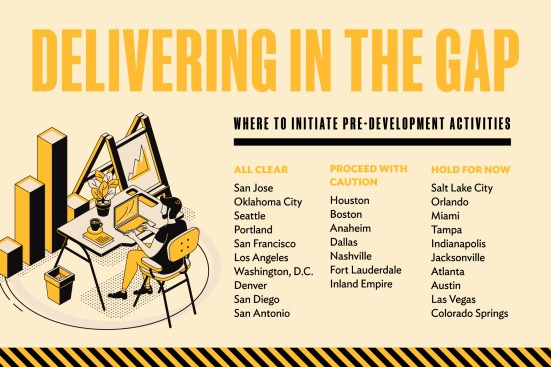
It’s no secret that residential development is cyclical, and the multifamily sector is currently experiencing mixed conditions with steady supply coming online and lower starts.
“We’re at a point of vulnerability here, but it’s natural,” notes Omar Rihani, executive vice president and national residential sector leader at Project Management Advisors. “You can’t perfectly deliver supply to meet demand. It just takes too long to deliver housing. We’re entering the period where starts are way down and slowing, and the demand continues to outstrip the supply.”
Confidence in the market for new multifamily housing declined year over year in the first quarter of 2024, according to the National Association of Home Builders’ Multifamily Market Survey released in May. The Multifamily Production Index, which measures builder and developer sentiment about current production conditions in the apartment and condo market, had a reading of 47, down three points year over year. The index is scaled so that a number below 50 indicates that more respondents reported conditions are poor versus good.
“Owners of existing apartments continue to report strong occupancy, but this has the potential to soften when more of the 900,000-plus apartments currently under construction come online,” said NAHB chief economist Robert Dietz in a release. “NAHB is currently projecting that multifamily starts will fall 28% this year as developer activity slows.”
The under-construction pipeline has been dropping consistently the past couple of quarters and will continue that trajectory, says Kimberly Byrum, managing principal for multifamily at Zonda, MFE’s parent company. In her recent multifamily market update webinar, Byrum also noted that U.S. multifamily deliveries will peak in the second quarter of 2025.
“We’re currently in our first wave of deliveries, over 400,000 units are being delivered as of the first quarter. We expect to see a second large wave of deliveries hitting the market in the second quarter of 2025. Those are when the two big waves of new construction will be hitting the market,” Byrum said. “By the fourth quarter of 2026, we are at what I would consider the gap. The gap is below 300,000 units. So if you were to ask me today, ‘When is the best time to deliver units into the market?’ that would be after the fourth quarter of 2026.”
Tom Tomaszewski, president of The Annex Group and chairman of NAHB’s Multifamily Council, notes that the anticipated decline in deliveries could lead to inflationary pressures in 2026 and 2027. “To combat this, we are focusing on investing in and pursuing [low-income housing tax] credit–supported properties and providing as much affordable housing as possible across various states,” he says.
Top Challenges
For Chip Bay, chief construction officer at Mill Creek Residential, the past four-plus years “have been among the most challenging in our industry, at least in my experience. Today, while the market has softened, we have not seen a real pullback in costs. Some areas have improved, while others have not.”
When talking to multifamily developers and builders, Dietz says the top issues he hears about are financing and the availability and cost of skilled labor. Rounding out this list includes high interest rates, skilled labor shortages, high insurance rates, code changes, municipal approvals and permitting, high construction costs, and price clarity in the market.
“The three biggest challenges we are facing now in multifamily construction are the cost of capital to finance construction loans, skilled labor shortages, and the recent run-up of construction costs,” says Tomaszewski. “We have seen a leveling off of pricing; however, the run-up over the past three years has nearly doubled our cost of construction. It is harder and harder to get deals to pencil, and more deals are in need of additional support.”
Rate Uncertainty
For the most part, Tomaszewski says 2024 has unfolded as expected. “Many in our industry were hopeful for interest rate cuts starting this year, but it seems unlikely that rates will decrease until the end of the year at the earliest,” he says. “This ongoing high interest rate environment is making it difficult for developers to start new projects, which will impact supply in the coming years.”
Similarly, Rihani notes that the biggest surprise so far this year has been on the interest rate side. “There might be a little relief this year, but maybe not as much as was anticipated,” he says.
Higher interest rates have also been the biggest obstacle for CAPREIT, pushing starts back about six to eight months, says Chris Pilato, the firm’s chief development and construction officer.
“New construction continues to be a challenge,” Pilato explains. “With interest rates stubbornly high, it is very difficult to make deals work financially. We have a couple of projects moving forward in the Sun Belt, but it is a slow process. On the encouraging side, we have seen construction prices trending downward, which is a positive sign for future growth.”
Byrum says the industry is “really concerned about the Fed funds rate and inflation.” She says expectations for third quarter and fourth quarter rate cuts are high, and if there is not a rate change until November or after, it will be the longest period on record with no rate change.
Supply Chain Stabilization
While there are some lingering supply chain issues, the general consensus is that the major disruptions are in the rearview mirror. The biggest issue of late seems to be with “devices related to power,” Bay says, such as switchgear and transformers. Dietz notes that some apartment developers say they’ve slowed down timelines because they can’t guarantee when they’ll get that equipment.
“Material supply chain issues and pricing have started to stabilize,” Tomaszewski says. “While we still face delays with specific items like transformers, the severe disruptions we encountered previously have largely been resolved. We’ve seen a leveling off of material price increases and continue to apply best practices developed during the height of the supply chain disruptions to stay ahead in ordering and inventory management.”
In addition to power-related infrastructure, Bay says Mill Creek occasionally experiences issues with appliance availability or concrete, but “we continue to see improvement in pricing as the market slows in terms of starts.”
Dietz points out there are still tariffs on lumber from Canada, which accounts for about one-third of the lumber supply. The current 9% tariff could go up to 13%, he says. Building materials pricing has been relatively flat over the past year, but gypsum pricing is going up. While things are better than they were in 2021, Dietz says gains in single-family construction could result in some tightening.
Labor Focus
Rihani says labor is a more pressing issue for the multifamily industry than building materials. “I think there’s a lot of noise when it comes to materials,” he says. “We don’t see materials availability and pricing as an issue today. I think where there is more risk is in labor.”
Mill Creek has scaled up its construction team over the past three years, doubling its size. The company has also made recruiting and retention a top focus.
“While we are known for our communities, our amenities, and the service that our property operations groups provide, we really should be known for our people,” Bay says. “They make the difference for us every day. When it comes to building the team and retention, we focus on the interviewing and onboarding process while aiming to build and maintain a culture that folks want to be a part of.”
Pilato says CAPREIT is seeing a decline in overall construction in the market, which has “provided us with a bigger pool of contractors and skilled labor” because the company subcontracts all its work.
Attracting young people to the trades remains challenging, Tomaszewski says. As a result, The Annex Group focuses “on strong relationships with subcontractors, investing in those relationships heavily. We have several reliable subcontractors who travel with us, and we diligently vet new contractors when entering new communities to ensure adequate workforce for our projects.”
Policy Impact
The industry continues to deal with regulatory red tape, which drives up costs and impacts project timelines. Regulations at various government levels account for more than 40% of multifamily development costs.
“While these regulations are well-intentioned, they often lead to unintended consequences that add unnecessary costs to building multifamily units,” Tomaszewski says.
Pilato says CAPREIT is experiencing challenges with municipal approvals and permitting, which he thinks will become more burdensome over time.
“High impact and regulatory fees drive up our overall project costs,” he says. “This limits what markets we can develop in, as we need higher rents and square footage to achieve an acceptable return on investment.”
For Mill Creek, Bay points out that code changes “are an ongoing challenge that impact pricing, affordability, and the construction process.”
In April, the Department of Housing and Urban Development (HUD) and U.S. Department of Agriculture (USDA) issued a final determination that requires all HUD- and USDA-financed new single-family construction housing to be built to the 2021 International Energy Conservation Code (IECC) and HUD-financed multifamily housing be built to 2021 IECC or ASHRAE 90.1-2019. The rule went into effect May 28, but the compliance dates for the building code mandates are 12 months after the effective date for multifamily projects; 18 months after the effective date for single-family homes; and 24 months after the effective date for homes in “persistent poverty rural areas.”
According to NAHB, this mandate will do little to curb overall energy use but will exacerbate the housing affordability crisis and hurt the nation’s most vulnerable house hunters and renters.
“Typically codes are determined at the local level, so this is using the housing finance level to implement energy codes at the local level; builders and developers will have to build to a tighter energy code,” Dietz says.
To some degree, Rihani says policymakers are starting to and will continue to acknowledge that developers “can’t just keep getting clobbered” with regulations and exemptions. “I think in development, you have to be an eternal optimist and seize the good in these situations,” he continues. “I hope policy will catch up—we have to be partners in this and not just adversaries. Policy has to help alleviate the housing shortage. There’s no way around it, especially because it’ll take multiple years for housing to come to fruition. Policy has to catch up, and it has to catch up today.”
Dietz says regulatory discussions are always part of his travels. “I tell builders on the road that we need to convince a certain number of NIMBYs who are skeptical of change, we have to work with the YIMBY movement—often young people who are frustrated by the lack of apartments—and the industry has to outright oppose the BANANAs, those who want you to build absolutely nothing anywhere near anything,” he explains.
Along those lines, Tomaszewski says his firm advocates for YIMBY principles because when local communities support their projects, they are much more successful.
The most intense fights on residential construction are at the local level, Dietz explains. “Focus is often given to federal government issues, but really it’s a market-by-market case,” he adds. “Markets that have flexible zoning rules and allow construction of density—those areas that can provide housing supply are going to attract businesses.”
Dietz says zoning reform is met with more understanding today than when he’d testify at state legislatures 10 years ago, “but the proof is in the pudding, and only a certain number of communities have really made changes.”

Hot Markets
The Annex Group is particularly active in what Tomaszewski calls “secondary medium market cities, where there is a significant need for affordable and high-quality housing units.” He says these markets—such as Des Moines, Iowa; Lincoln, Nebraska; Wichita, Kansas; and Ann Arbor, Michigan—tend to have less regulatory red tape, and city governments are typically more welcoming of affordable housing projects.
In the short term, Pilato thinks the increased supply and lower starts will put pressure on rents in supply-heavy markets. “We have seen this in Nashville, Tennessee, with our existing communities,” he says. “From a long-term perspective, the lower starts will continue to put pressure on supply and move rents higher. In the markets we are developing—Greenville, South Carolina, and Southwest Florida—there is still high demand and relatively low supply.”
Mill Creek—ranked No. 2 on the 2024 NMHC Top 25 Developers list—is currently active in more than 20 markets, says Bay, noting that the busiest are Phoenix, Seattle, Nashville, and South Florida.
In her webinar, Byrum presented a breakdown of markets where she says it’s OK to initiate pre-development activities for multifamily projects to deliver in the gap come 2026; she also includes a “hold for now” list—to which she says she would also add Charlotte and Raleigh in North Carolina, which have a pipeline they’re working through.
Looking Ahead
Economic uncertainty will continue to string us along through 2024, according to Byrum. While the coming months will present challenges, those in the industry seem ready to overcome them.
“We’re seeing groups position themselves cautiously to move very quickly if they sense there is interest rate relief on the horizon,” Rihani says. “Folks who want to deliver in 2026 and 2027, there’s a lot of conservativeness when it comes to spending money today to get to that outcome, especially in some of these more regulated markets where the capital may not be there. Everyone’s moving forward prudently at this point.”
Pilato notes that while new construction is slow going, existing community renovation initiatives are moving in a positive direction. “Renovation prices are coming down, and contractor interest in projects is improving,” he says. “Renovated unit rents continue to maintain their premium and demand.”
Byrum mentioned she’s hearing more about how “it’s an election year,” and it remains to be seen how the outcomes in November will impact the industry. Dietz notes that elections have consequences. He says if there is a second go for the Trump administration, there likely would be impacts on immigration and international trade policy, and a focus on eliminating or stopping regulatory policies on the land development side. If President Joe Biden is reelected, there will be an ongoing focus on energy efficiency and environmental rules.
Another area to watch is the build-to-rent (BTR) sector. “When you think about BTR, you really have to think about demographics,” Byrum said. “Currently, the median age of a first-time home buyer is 36 years old. This BTR product really meets the need for these millennials. Another interesting part is that the oldest Gen Xers and the youngest baby boomers, they may be prime candidates for BTR as well.”
“The dynamics of a high interest rate environment are playing out in a lot of different ways,” Rihani says, noting that his company is particularly interested in the 55-plus market and how the industry will serve that demographic. “For a baby boomer couple who wants to downsize but doesn’t really want to buy a home when they’ve paid off a house already or want more cash in their pocket, I think the trend of renting over ownership will continue and be more pronounced in the near term,” he says.
Opinions on the housing shortage vary, but Zonda estimates it’s between 1.5 million to 3 million homes, with 310,000 to 400,000 multifamily units needing to be delivered per year to keep markets balanced and address demographic growth.
“Whether single-family or multifamily, the solutions to the housing deficit are not simple,” Dietz says. “There’s no single simple scalable solution. It’s all about trying to make improvements to zoning rules, regulatory rules, and making sure financing is available for for-rent and for-sale. The housing market is a ladder—every rung has to work.”
